
Core & Innovation: invest in the new possible
ETFs can offer convenient access to broad and diversified baskets of bonds at a low cost. Discover our range of fixed income ETFs.

Fixed income yields have risen substantially since central banks began acting to combat inflation. This dramatic reset has driven yields to levels not seen since the Global Financial Crisis, but still leaves today’s income investors with difficult choices. While interest rates in most major developed economies might be at or very near their peaks in this hiking cycle, inflation remains an issue and, while the US Treasury yield curve has been steepening since the end of June, it was previously deeply inverted, which has often been a precursor to recession.
Where to invest now depends on your outlook and risk appetite, but if you’re considering corporate bond markets, here are some alternative, potentially higher yielding or higher quality opportunities, that you can access with ETFs.
Certain fixed income asset classes can provide an interesting opportunity if you look beyond traditional senior debt. A company can issue securities across its capital structure, and different levels of seniority mean that certain securities can offer investors higher yields without having to compromise on the credit quality of the issuer. Additional Tier 1 (AT1) capital bonds, corporate hybrid bonds and preferred shares are non-traditional asset classes that have historically provided higher yields while exhibiting low correlations to traditional fixed income, often with lower interest rate risk.
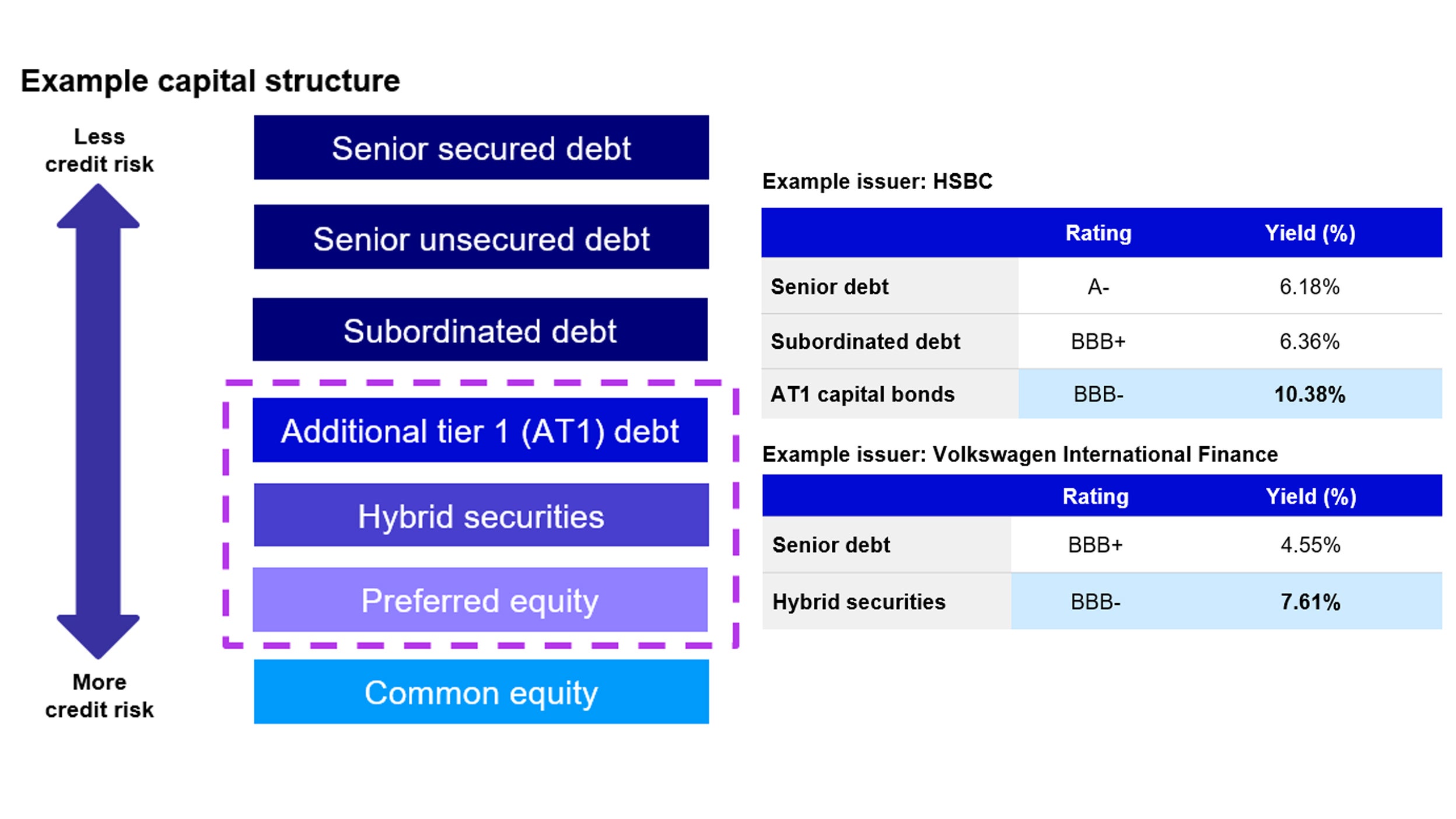
Data: Bloomberg, 30 Oct 2023. The mention of securities is for illustrative purposes only and is not intended as a recommendation to invest in any particular asset class, security or strategy.
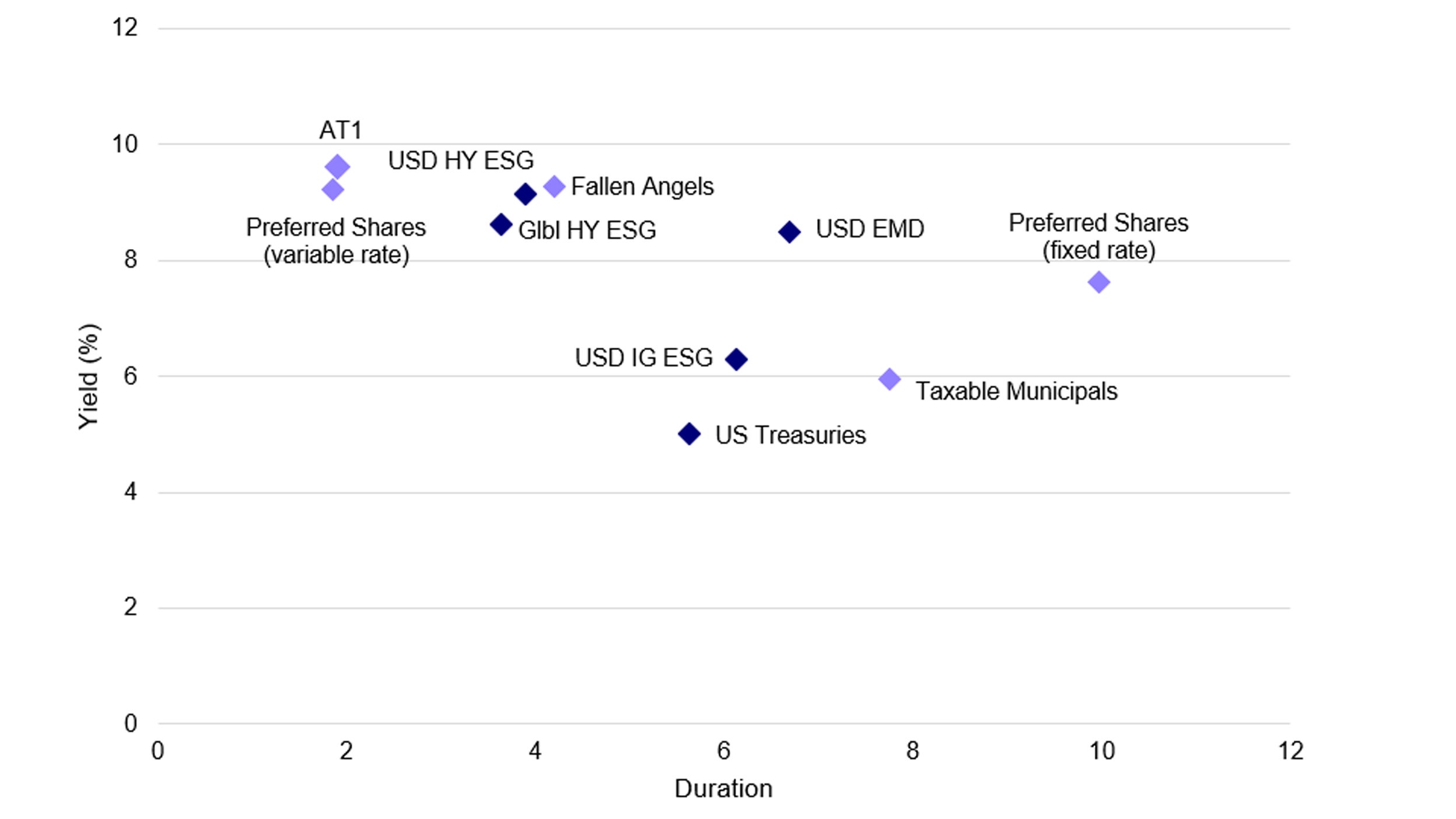
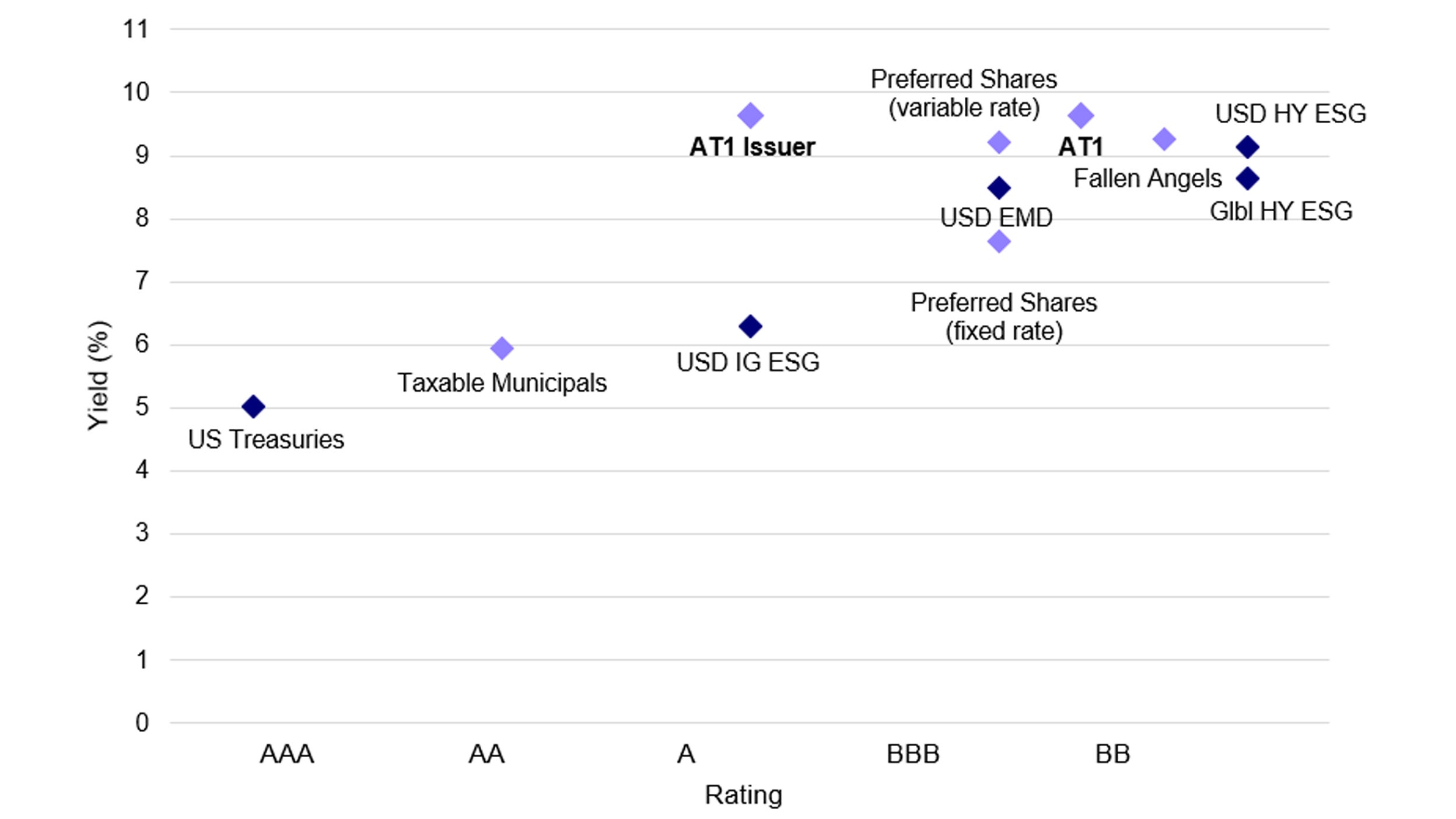
Source: Aladdin, based on ETF yields as at 30 Oct 2023
These innovative income securities have several key features that make them attractive to yield-seeking investors:
Subordination brings with it an extra element of risk, however, hence the higher yields these securities typically have to offer in order to attract investors. That many of these securities are issued by large banks or companies with investment grade credit ratings may provide you with some comfort, but you need to assess whether the additional yield compensates for the risk involved.
If your risk appetite extends beyond investment grade, we can take a more selective approach aimed at benefiting from the price rebound associated with high yield “fallen angels”, while also improving overall credit quality. Fallen Angels are the bonds from issuers that have recently had their credit ratings downgraded from investment grade to high yield. These bonds offer investors the potential for both income and capital gains. Fallen angels typically generate high income and benefit from a price rebound shortly after downgrade. They also tend to have higher credit quality, with 89% rated above B+, compared to only 46% for the broader US high yield market.
A smart way to capture the price rebound of fallen angels is to use a time-weighted, systematic methodology. The FTSE Time-Weighted US Fallen Angel Bond Select Index uses this approach to efficiently capture the price rebounds of fallen angels, which targets greater capital appreciation in US high yield. ETFs can be a simple and efficient way to access this strategy.
Bonds are added to the index within 30 days of a downgrade to high yield, with weights reducing over time to maximize exposure to any short-term rebound. The gradual reduction in weighting also reflects the diminishing probability that the fallen angel will be upgraded back to investment grade.
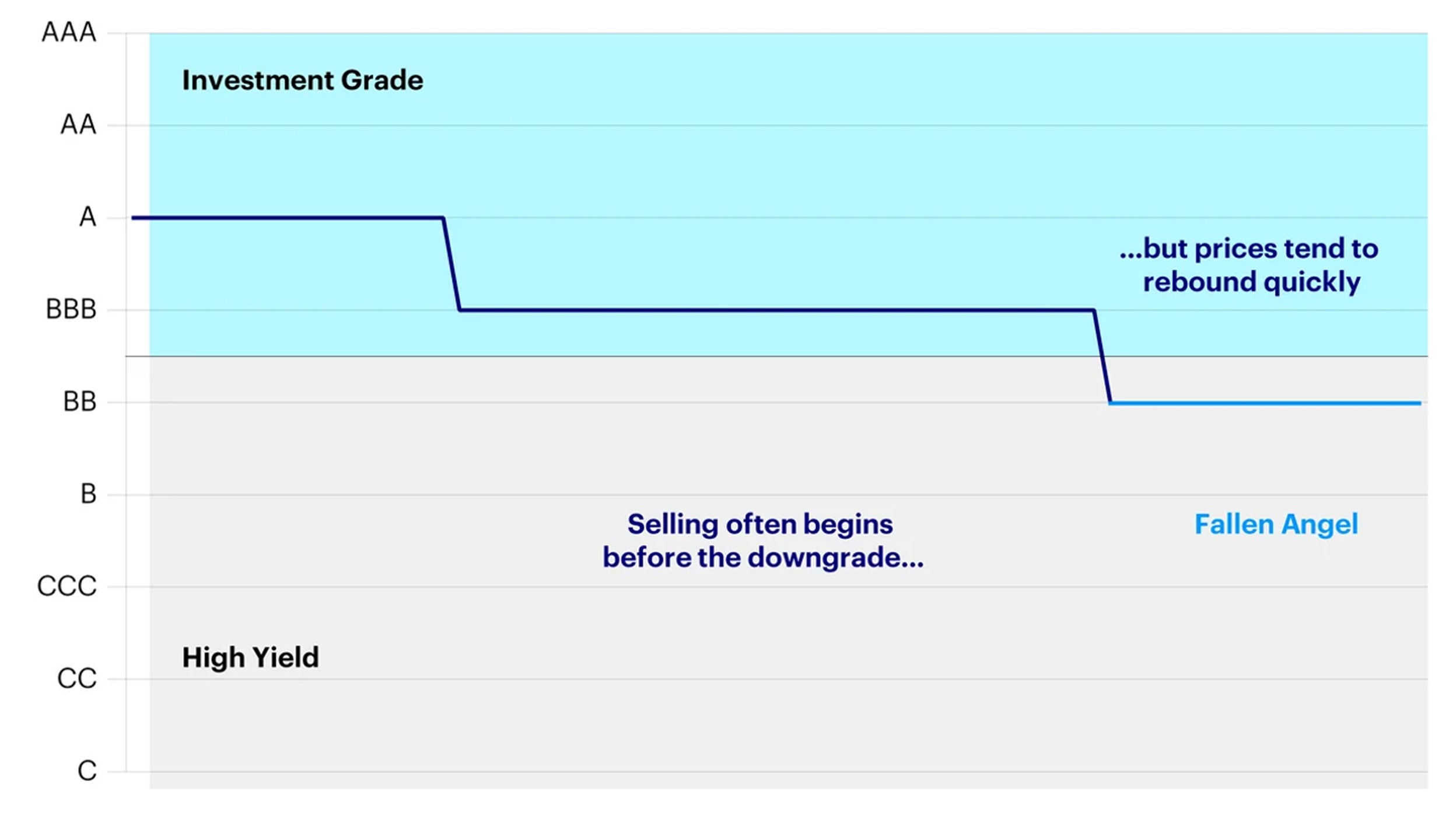
Source: Invesco. For illustrative purposes only.
Source: FTSE, Bloomberg, as at 30 September 2023.
If you’re looking for a higher quality alternative to traditional corporate bonds, it might be worth considering US taxable municipal bonds (or “munis”). Their average rating sits about halfway between US Treasuries and investment grade credit, but they offer two-thirds of the spread over Treasuries that is provided by investment grade credit. While munis have historically performed in a similar manner to investment grade credit, their average rating is four notches higher and their historical default rate is just 0.18% (versus 1.74% for investment grade credit), making taxable munis superior to traditional investment grade from a credit perspective.
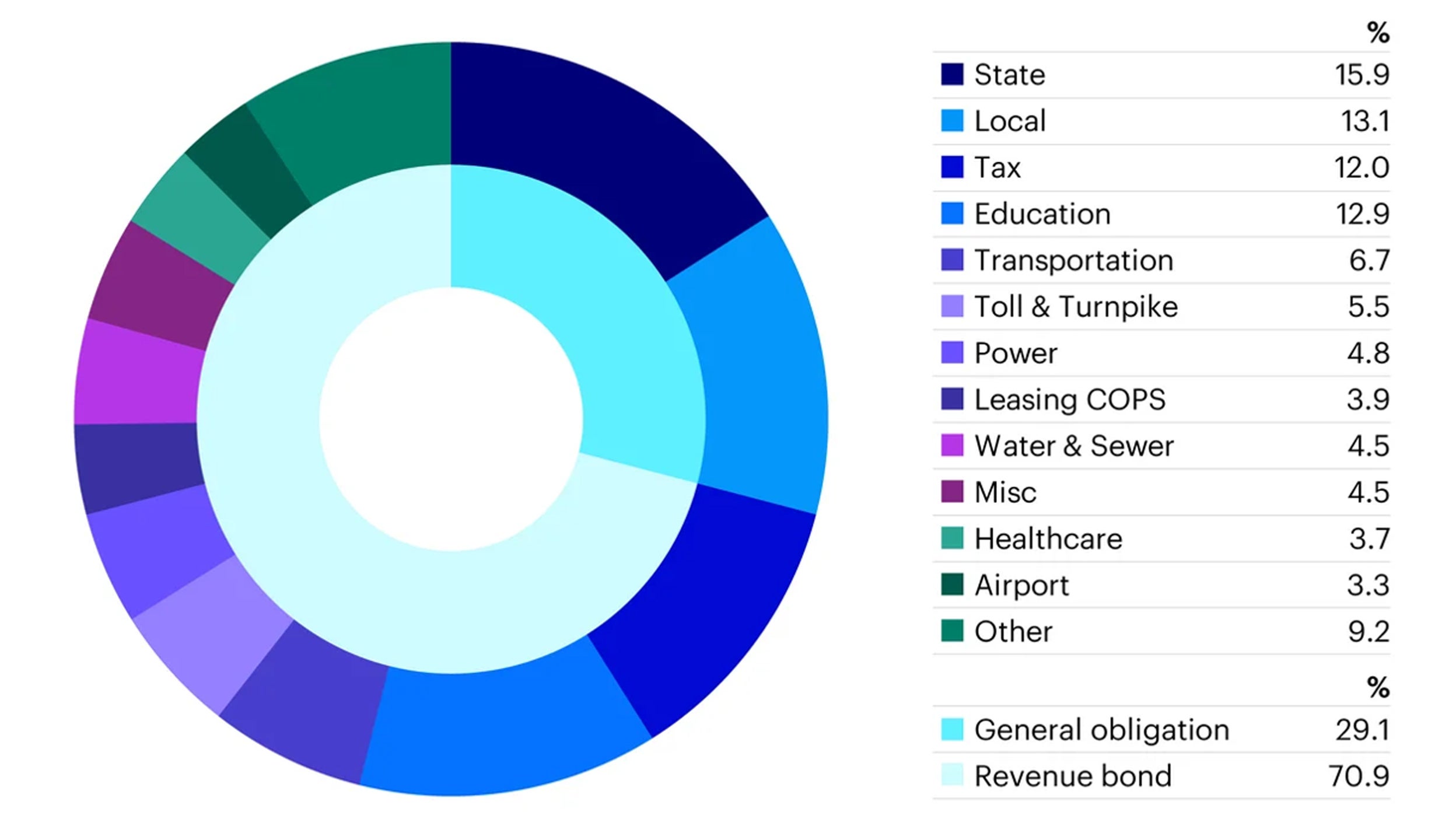
Source: ICE, Invesco, US Securities and Exchange Commission. Weights as at 30 September 2023 based on the ICE BofA US Taxable Municipal Securities Plus Index.
|
IG |
Taxable Munis |
|---|---|---|
Yield |
6.33% |
5.89% |
Spread |
132bp |
88bp |
Duration |
6.28 |
7.67 |
Ave rating |
A- |
AA |
Def |
1.74% |
0.18% |
Source: Bloomberg, ICE, 30 September 2023. Taxable Munis is the ICE BofA US Taxable Municipal Securities Plus Index. Investment Grade Credit is the ICE BofA US Corporate Index. Default rate based on http://www.msrb.org/msrb1/pdfs/MSRB-Muni-Facts.pdf using Moody’s data for 1970-2016
The taxable municipal bond market has many issuers and over 81,000 issues, making it very difficult for investors to gain diversified exposure via individual bond purchases. The market is dominated by institutional investors and access to the bonds can be difficult, unless ticket sizes are large. Liquidity is often sourced via primary market issuance (the equivalent of an IPO). Due to these challenges, ETFs could be the most cost-effective way for many investors to gain exposure.
For investors looking to gain exposure to these innovative fixed income strategies, we believe ETFs can be an attractive option for several key reasons:
If you’re looking at income opportunities outside of government bonds, ETFs provide a range of alternative exposures to traditional credit. Some of the more innovative asset classes can offer potentially higher yields as well as possible diversification benefits, including those seeking to take advantage of subordination in an issuer’s capital structure. Meanwhile, allocations to taxable municipal bonds and fallen angels could even improve the credit quality of portfolios comprising traditional investment grade and high yield bonds. Whatever suits your objectives, risk budget and economic outlook, ETFs are efficient investment tools to target specific parts of the bond market.
For complete information on risks, refer to the legal documents.
Value fluctuation: The value of investments, and any income from them, will fluctuate. This may partly be the result of changes in exchange rates. Investors may not get back the full amount invested.
Securities lending: The Fund may be exposed to the risk of the borrower defaulting on its obligation to return the securities at the end of the loan period and of being unable to sell the collateral provided to it if the borrower defaults.
Concentration: The Fund might be concentrated in a specific region or sector or be exposed to a limited number of positions, which might result in greater fluctuations in the value of the Fund than for a fund that is more diversified.
Applies to Invesco US Municipal Bond, Invesco AT1 Capital Bonds UCITS ETF, Invesco High Yield Fallen Angels UCITS ETF, Invesco Variable Rate Preferred Shares UCITS ETF only.
Credit risk: The creditworthiness of the debt the Fund is exposed to may weaken and result in fluctuations in the value of the Fund. There is no guarantee the issuers of debt will repay the interest and capital on the redemption date. The risk is higher when the Fund is exposed to high yield debt securities.
Interest Rates: Changes in interest rates will result in fluctuations in the value of the fund.
Applies to Invesco AT1 Capital Bonds UCITS ETF only.
Contingent Convertible Bonds: This fund invests in contingent convertible bonds, a type of corporate debt security that may be converted into equity or forced to suffer a write down of principal upon the occurrence of a pre-determined event. If this occurs, the Fund could suffer losses. Other notable risks of these bonds include liquidity and default risk.
Applies to Invesco US High Yield Fallen Angels UCITS ETF only.
Non-investment grade securities/High Yield debt instruments: This fund may hold a significant amount of debt instruments which are of lower credit quality. This may result in large fluctuations of the value of the ETF as well as impacting its liquidity under certain circumstances.
Applies to Invesco Preferred Shares UCITS ETF and Invesco Variable Rate Preferred Shares UCITS ETF only.
Equity: The value of equities and equity-related securities can be affected by a number of factors including the activities and results of the issuer and general and regional economic and market conditions. This may result in fluctuations in the value of the Fund.
Data as at 30.09.2023, unless otherwise stated. By accepting this material, you consent to communicate with us in English, unless you inform us otherwise. This is marketing material and not financial advice. It is not intended as a recommendation to buy or sell any particular asset class, security or strategy. Regulatory requirements that require impartiality of investment/investment strategy recommendations are therefore not applicable nor are any prohibitions to trade before publication.
Views and opinions are based on current market conditions and are subject to change. For information on our funds and the relevant risks, refer to the Key Information Documents/Key Investor Information Documents (local languages) and Prospectus (English, French, German), and the financial reports, available from www.invesco.eu. A summary of investor rights is available in English from www.invescomanagementcompany.ie. The management company may terminate marketing arrangements. UCITS ETF’s units / shares purchased on the secondary market cannot usually be sold directly back to UCITS ETF. Investors must buy and sell units / shares on a secondary market with the assistance of an intermediary (e.g. a stockbroker) and may incur fees for doing so. In addition, investors may pay more than the current net asset value when buying units / shares and may receive less than the current net asset value when selling them. For the full objectives and investment policy please consult the current prospectus.
Munis
The value of investments, and any income from them, will fluctuate. This may partly be the result of changes in exchange rates. Investors may not get back the full amount invested.
The creditworthiness of the debt the Fund is exposed to may weaken and result in fluctuations in the value of the Fund. There is no guarantee the issuers of debt will repay the interest and capital on the redemption date. The risk is higher when the Fund is exposed to high yield debt securities.
Changes in interest rates will result in fluctuations in the value of the fund.
The Fund may be exposed to the risk of the borrower defaulting on its obligation to return the securities at the end of the loan period and of being unable to sell the collateral provided to it if the borrower defaults.
The Fund might be concentrated in a specific region or sector or be exposed to a limited number of positions, which might result in greater fluctuations in the value of the Fund than for a fund that is more diversified.
Source ICE Data Indices, LLC is used with permission. ICE® is a trademark of ICE Data or its affiliates. This trademark has been licensed, along with the Reference Index for use by the Fund. The Reference Index is maintained and calculated by ICE Data and ICE Data is the administrator of the Reference Index. ICE Data is not affiliated with the Fund or any of its affiliates. The Manager has entered into a license agreement with ICE Data to use the Reference Index. Neither the Manager nor the Fund is sponsored, endorsed, sold or promoted by ICE Data its affiliates or its third-party suppliers (“ICE Data and its Suppliers”). ICE Data and its Suppliers make no representations or warranties regarding the Manager or the Fund or the advisability of investing in securities generally, in the Fund particularly, or the ability of the Reference Index to track general stock market performance. ICE Data’s only relationship to the Manager is the licensing of certain trademarks and trade names and the Reference Index or components thereof. The Reference Index is determined, composed and calculated by ICE Data without regard to the Manager or the Fund or its holders. ICE Data has no obligation to take the needs of the Manager or the holders of the Fund into consideration in determining, composing or calculating the Reference Index. ICE Data is not responsible for and has not participated in the determination of the timing of, prices of, or quantities of the Fund to be issued or in the determination or calculation of the equation by which the Fund is to be priced, sold, purchased, or redeemed. Except for certain custom index calculation services, all information provided by ICE Data is general in nature and not tailored to the needs of the Manager or any other person, entity or group of persons. ICE Data has no obligation or liability in connection with the administration, marketing, or trading of the Fund. ICE Data is not an investment advisor. Inclusion of a security within an index is not a recommendation by ICE Data to buy, sell, or hold such security, nor is it considered to be investment advice. ICE Data and its suppliers disclaim any and all warranties and representations, express and/or implied, including any warranties of merchantability or fitness for a particular purpose or use, including the reference index, index data and any information included in, related to, or derived therefrom (“index data”). ICE Data and its suppliers shall not be subject to any damages or liability with respect to the adequacy, accuracy, timeliness or completeness of the underlying index and the index data, which are provided on an “as is” basis and your use is at your own risk.
The iBoxx USD Contingent Convertible Liquid Developed Market AT1 (8% Issuer Cap) referenced herein is the property of Markit Indices Limited and is used under license. The funds or securities referred to herein are not sponsored, endorsed, or promoted by Markit Indices Limited.
The Invesco US High Yield Fallen Angels UCITS ETF (the “Fund”) has been developed solely by Invesco. The “Fund” is not in any way connected to or sponsored, endorsed, sold or promoted by the London Stock Exchange Group plc and its group undertakings (collectively, the “LSE Group”). FTSE Russell is a trading name of certain of the LSE Group companies. All rights in the FTSE Time-Weighted US Fallen Angel Bond Select Index (the “Index”) vest in the relevant LSE Group company which owns the Index. “FTSE®” is a trade mark of the relevant LSE Group company and is used by any other LSE Group company under license. “TMX®” is a trade mark of TSX, Inc. and used by the LSE Group under license. The Index is calculated by or on behalf of FTSE International Limited or its affiliate, agent or partner. The LSE Group does not accept any liability whatsoever to any person arising out of (a) the use of, reliance on or any error in the Index or (b) investment in or operation of the Fund. The LSE Group makes no claim, prediction, warranty or representation either as to the results to be obtained from the Fund or the suitability of the Index for the purpose to which it is being put by Invesco.
"BofA Merrill Lynch" and "The BofA Merrill Lynch Diversified Core Plus Fixed Rate Preferred Securities Net Total Return Index" are reprinted with permission. ©Copyright 2017 Merrill Lynch, Pierce, Fenner & Smith Incorporated (“BofAML”). All rights reserved. "BofA Merrill Lynch" and "The BofA Merrill Lynch The BofA Merrill Lynch Diversified Core Plus Fixed Rate Preferred Securities Net Total Return Index" (“Index”) are service marks of BofAML and/or its affiliates and have been licensed for use for certain purposes by Invesco (“Adviser”) on behalf of the Invesco Preferred Shares UCITS ETF (“Fund”) that is based on the Index, and is not issued, sponsored, endorsed or promoted by BofAML and/or its affiliates nor is BofAML and/or its affiliates an adviser to the Fund. BofAML and its affiliates make no representation, express or implied, regarding the advisability of investing in the Fund or the Index and do not guarantee the quality, accuracy or completeness of the Index, index values or any index related data included herein, provided herewith or derived therefrom and assume no liability in connection with their use. As the index provider, BofAML is licensing certain trademarks, the Index and trade names which are composed by BofAML.
EMEA 3203491/2023